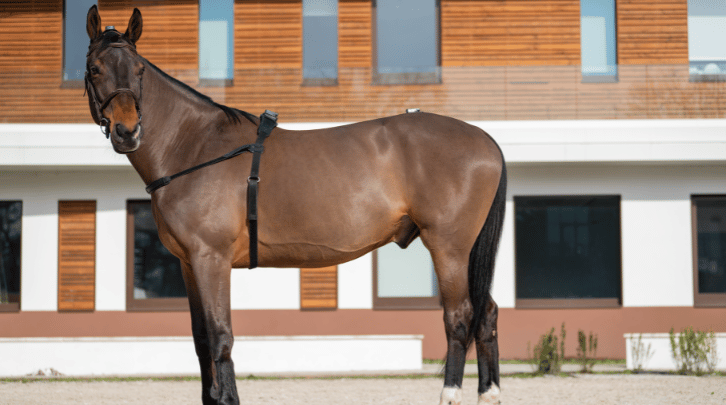Objective analysis of equine locomotion has become essential for refining lameness diagnosis and monitoring the progression of horses. Thanks to EQUISYM®, veterinarians have a reliable and precise tool to quantify locomotor asymmetries.
But why has the withers-mounted sensor become a gold standard in data interpretation? This decision is supported by extensive field experience and scientific validation.
Why is the withers sensor important?
The withers, located at the junction between the neck and the back, represent a biomechanically stable anatomical region, minimally influenced by extraneous movements or direct handler interference. Unlike the head, withers motion reliably reflects trunk dynamics and provides a more accurate readout of locomotor asymmetries.
Why integrate a withers sensor?
Integration of the withers sensor addresses two main objectives:
- Measurement reliability: The withers constitute a stable anatomical region, faithfully mirroring trunk dynamics. Unlike the head, its kinematics are less affected by handler actions or extraneous artifacts (e.g., shaking, defensive behaviors).
- Clinical insights and differential diagnosis: Vertical displacement of the withers provides objective quantification of locomotor asymmetries that may otherwise remain visually undetectable. Combined analysis of asymmetries between head and withers, or between head and pelvis, enhances discrimination between :
- Head movement asymmetry directly associated with forelimb lameness
- And secondary head compensations related to hindlimb lameness
This multimodal approach enables more reliable interpretation and more precise identification of the primary lame limb (Persson‐Sjodin et al., 2024; Taddey et al., 2025).
The decision to integrate a withers sensor was supported and validated by the clinicians and biomechanics experts at CIRALE (the locomotion research and clinical center of the Normandy equine campus at EnvA), who directly contributed to the design and development of the EQUISYM® system, in partnership with Arioneo.
To learn more about EQUISYM® and its latest improvements, watch our video on EQUISYM®’s modular configuration, including the withers sensor, which enables precise and objective quantification of locomotor asymmetries.
During an interview with Dr. Allen Page, Assistant Professor specializing in equine health, we asked: “Do you think placing a sensor at the withers impacts measurement quality?”
His answer:
“I think having a sensor on the withers is an interesting and somewhat novel approach to diagnosing lameness. The horses have tolerated the device on their withers very well, which is great, especially since we work with research horses, many of which aren’t accustomed to saddles or equipment around their girth. I also think it’s beneficial because it shifts the focus away from the head. This reduces the impact of variability caused by handlers holding the lunge too tightly or by horses throwing their heads. With the withers sensor, you don’t have to worry about those factors affecting the measurements.”
Introduction to the EQUISYM® simple data analysis
1) Parameters
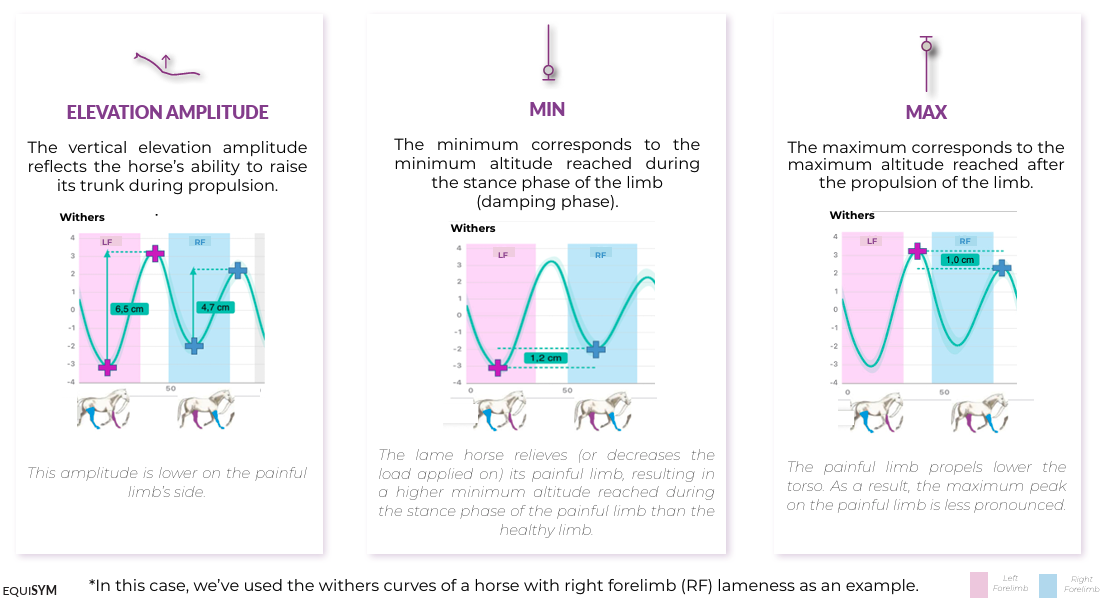
2) Analyze the curves
The graphs below represent the vertical displacement of the withers (in cm) during an average stride (average of all strides in the examination) at a trot and in a straight line.
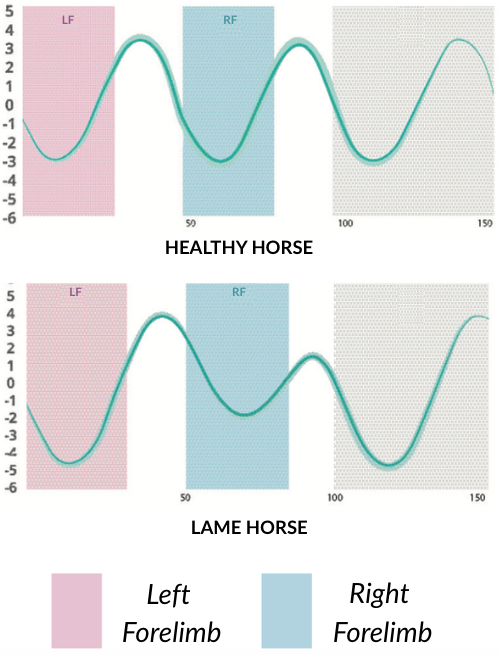
The stance phases of the left and right forelimbs are indicated by the colored rectangles.
The analysis of the vertical displacement of the withers is strongly correlated to forelimb asymmetries.
In this horse:
-
- The amplitude of vertical elevation is reduced during the right forelimb stance, indicating a right forelimb unloading.
- The minimum peak is lower on the right, reflecting reduced weight-bearing of the right forelimb.
- The maximum peak is also lower on the right, reduced propulsion of the right forelimb.
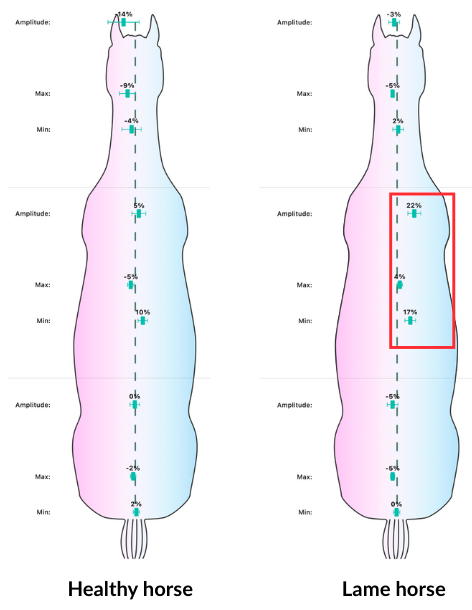
Diagnostic value of the withers sensor in characteristic clinical situations
1) Improved reliability of data when head motion is disturbed
When a horse exhibits parasitic head movements (shaking, swaying) or when the handler’s actions (lead rope tension, maintaining the head in a high position) interfere with cervical kinematics, data collected from a head-mounted sensor become difficult to interpret.
Several studies (Macaire et al. (2022), Persson‑Sjodin et al. (2024), Taddey et al. (2025), Timmerman et al. (2022)) have demonstrated that the vertical measurement at the withers show lower intra-horse variability than those from the head, particularly in cases of manual interference or parasitic movements.
In such situations, the withers sensor provides a more stable measurement, less affected by artifacts, as it directly reflects the vertical movement of the trunk.
For example, on the EQUISYM® Dashboard Vet, it is common to observe that the withers curve remains regular and interpretable, while the head curve displays erratic variations unrelated to actual lameness.

Visualization on the EQUISYM® Dashboard Vet of the vertical displacement curves for individual stride (thin line) and the average vertical displacement (bold line) of the head and withers over time (expressed as a percentage of the stride duration).
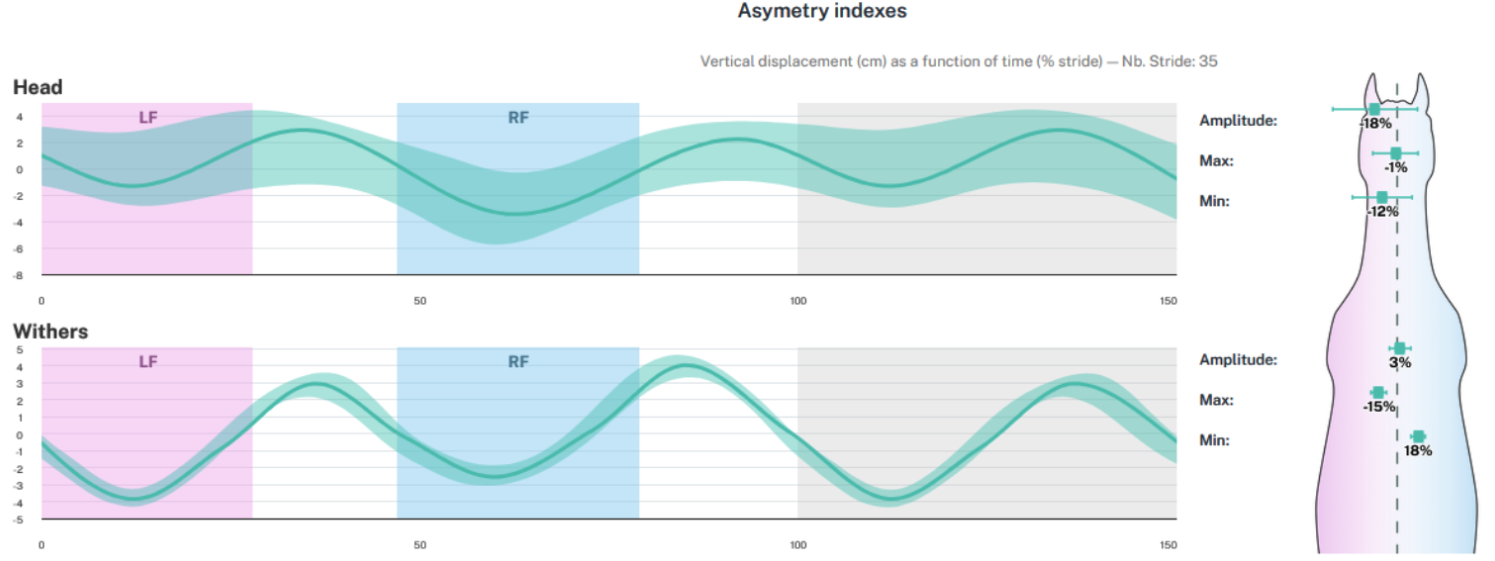
Visualization on the EQUISYM® Dashboard Vet of the average vertical displacement (green line) of both the head and withers over time (expressed as a percentage of the stride cycle), with standard deviation limits (green zone) for head and withers motion
2) Differentiating forelimb and hindlimb lameness
Several studies have shown that in cases of hindlimb lameness, horses frequently compensate by tilting the head toward the contralateral side of the lame limb in order to shift weight cranially (Rhodin et al., 2018; Marunova et al., 2022). When assessed solely through head motion, this compensatory strategy may be misinterpreted as a primary forelimb lameness.
However, combined analysis of withers asymmetries sometimes reveals an orientation opposite to that of the head, indicating the true origin of pain. In parallel, Persson‑Sjodin et al. (2024) confirm the clinical value of combining head-withers data to discriminate genuine forelimb lameness from secondary head compensations caused by hindlimb lameness.
a. Case of right forelimb lameness
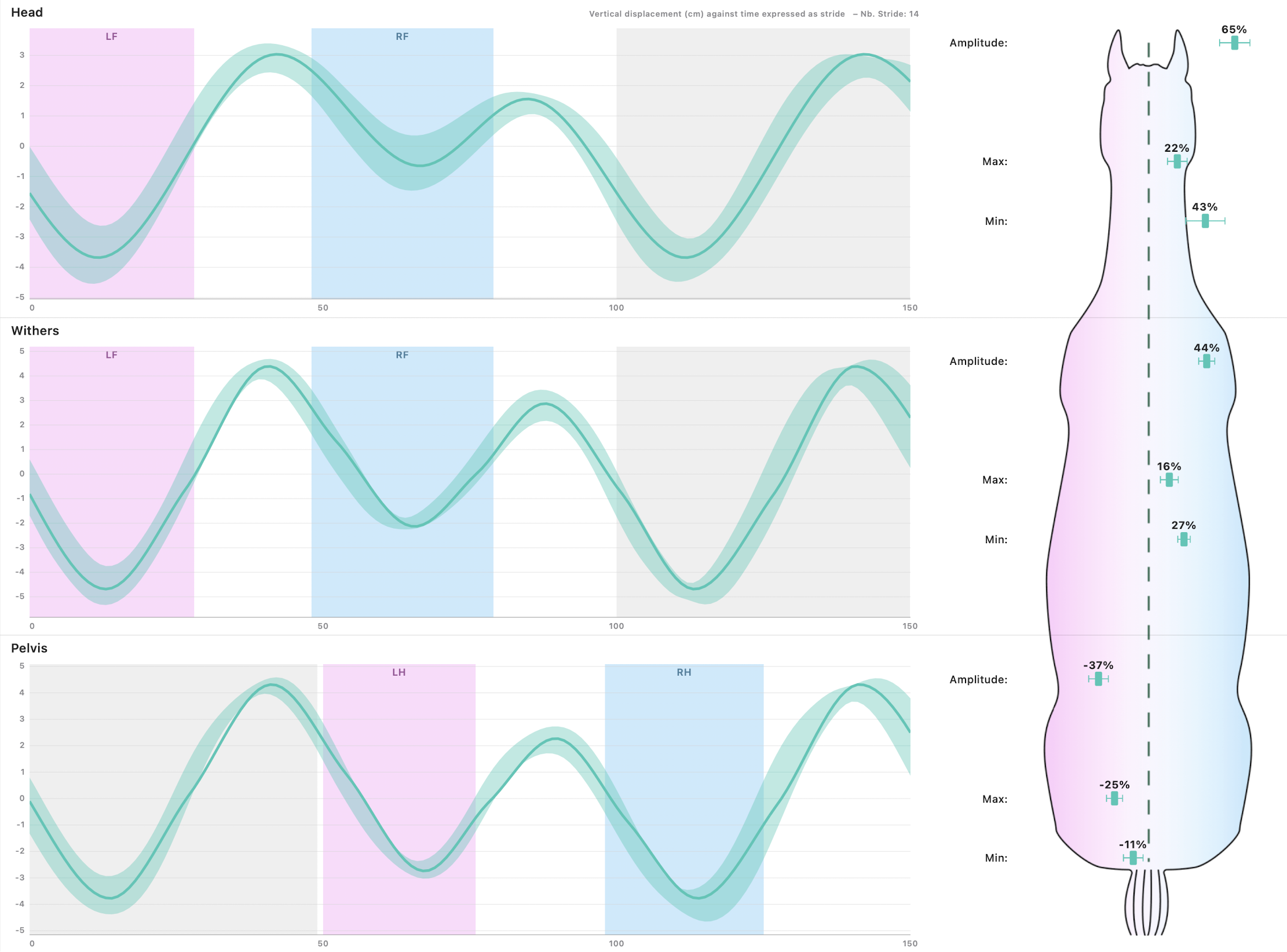
This exam was performed with EQUISYM®, on the lunge, at the trot, in a straight line on a hard surface.
The horse is a 12-year-old sport mare competing in amateur level in show jumping events. Following the onset of lameness, an EQUISYM® examination was conducted, which suggested a right forelimb weight-bearing deficit in a straight line, with asymmetry indices of 43% for the head and 27% for the withers. These indices indicate a right forelimb asymmetry, detected by the combined use of head and withers sensors.
The subsequent veterinary examination confirmed a solar bruise on the right forelimb.
b. Case of right hindlimb lameness
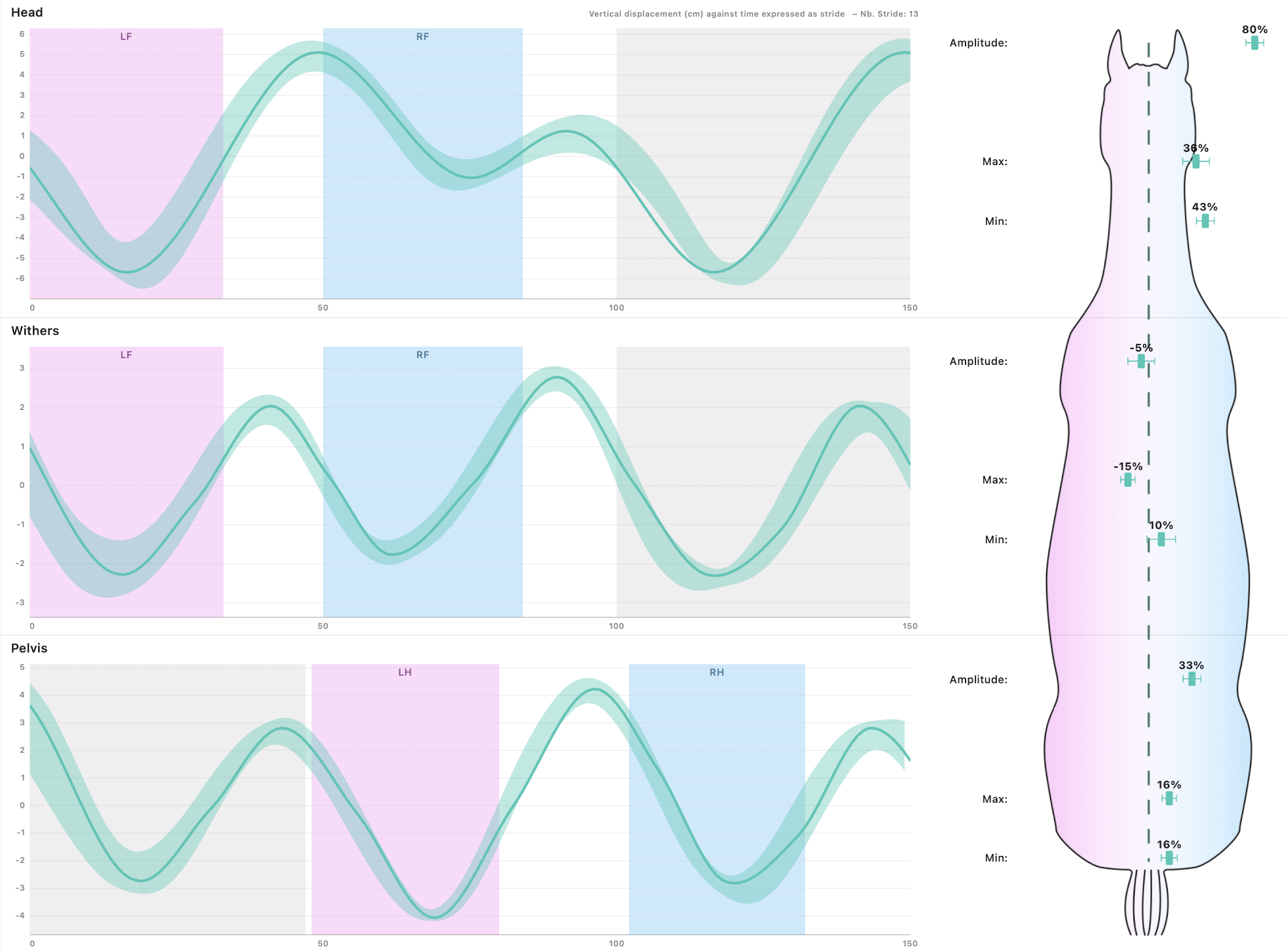
This exam was performed with EQUISYM®, on the lunge, at the trot, in a straight line on a hard surface.
The horse presented with a chronic intermittent lameness affecting multiple limbs, along with a lack of hindlimbs propulsion during courses.
Clinical examination revealed right hindlimb lameness, accompanied by a pronounced head-nodding movement toward the left forelimb.
An EQUISYM® examination was performed and suggested a deficit in vertical elevation amplitude of 80% for the head and 33% for the pelvis. These indices indicate a right hindlimb asymmetry, detected through the combined use of head and pelvic sensors.
Subsequent complementary examinations (radiographs and nerve blocks) confirmed the presence of a chronic fragment on the dorsoproximal aspect of the first phalanx (P1) of the right hindlimb.
3) Interpretation of a specific case of axial pathology
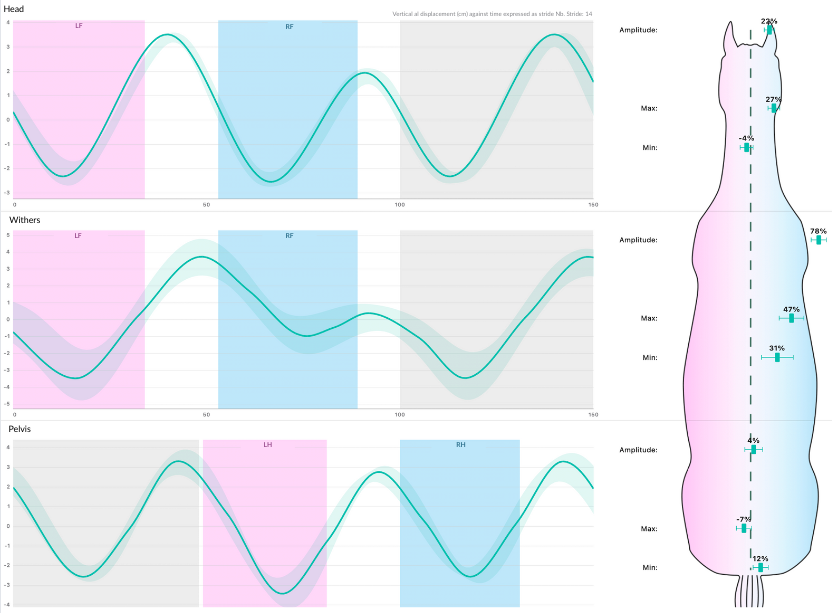
This exam was performed with EQUISYM®, on the lunge, at the trot, in a straight line on a hard surface.
The horse is an 8-year-old mare competing in amateur level in show jumping event. She was referred because her rider noticed a locomotion abnormality that had been evolving for over 6 months. On clinical examination, she displayed a right forelimb protraction deficit.
An EQUISYM® examination was performed and suggested a marked overall reduction in vertical withers amplitude, with an asymmetry index of +78% to the right. Head motion followed the same pattern, with a vertical amplitude deficit of +22%.
Certain conditions affecting the lower cervical region can induce locomotor asymmetries that do not necessarily manifest as abnormal head movements. In such cases, data from the head sensor may remain within normal limits, complicating the identification of anomalies based on head measurements alone.
The withers sensor, however, is directly influenced by trunk mobility alterations associated with cervical pain and can highlight significant vertical asymmetries that would escape detection if relying solely on head data.
Further imaging examinations on the mare revealed moderate epi-axial intervertebral synovial arthropathy, most pronounced at C6-C7 on the right side, associated with chronic synovitis.
Conclusion
Withers sensor data provide valuable insight into compensatory mechanisms and specific pathologies, demonstrating that head asymmetry alone cannot be interpreted exclusively as forelimb lameness.
Macaire et al. (2022, 2023) demonstrated that the vertical amplitude of the withers is the most discriminant asymmetry index for detecting forelimb lameness in a straight line. In a more recent study, Poizat et al. (2025) applied a machine learning method using indices from the head, withers, and pelvis on 287 horses, achieving an overall classification accuracy of 86%, highlighting the clinical relevance of the withers-mounted sensor in a multimodal approach.
By combining data from the withers, head, and pelvis, veterinarians gain a comprehensive and objective overview, essential for accurate diagnosis, monitoring, and decision-making.
Bibliographic references:
- Persson-Sjodin, E.; Hernlund, E.; Pfau, T.; Andersen, P.H.; Forsström, K.H.; Byström, A.; Serra Bragança, F.M.; Hardeman, A.; Greve, L.; Egenvall, A.; et al. Withers Vertical Movement Symmetry Is Useful for Locating the Primary Lame Limb in Naturally Occurring Lameness. Equine Vet. J. 2024, 56, 76–88.
- Taddey, CM.; Roecken, M.; Kreling, KM.; Cruz AM. Quantifying head and withers movement asymmetry in sound and naturally forelimb lame horses trotting on a circle on hard and soft surfaces. Equine Vet. J. 2025, 57, 1219–30.
- Macaire, C.; Hanne-Poujade, S.; De Azevedo, E.; Denoix, J.-M.; Coudry, V.; Jacquet, S.; Bertoni, L.; Tallaj, A.; Audigié, F.; Hatrisse, C.; et al. Investigation of Thresholds for Asymmetry Indices to Represent the Visual Assessment of Single Limb Lameness by Expert Veterinarians on Horses Trotting in a Straight Line. Animals 2022, 12, 3498.
- Timmerman, I.; Macaire, C.; Hanne-Poujade, S.; Bertoni, L.; Martin, P.; Marin, F.; Chateau, H. A Pilot Study on the Inter-Operator Reproducibility of a Wireless Sensors-Based System for Quantifying Gait Asymmetries in Horses. Sensors 2022, 22, 9533.
- Rhodin, M.; Persson-Sjodin, E.; Egenvall, A.; Serra Bragança, F.M.; Pfau, T.; Roepstorff, L.; Weishaupt, M.A.; Thomsen, M.H.; vanWeeren, P.R.; Hernlund, E. Vertical Movement Symmetry of theWithers in Horses with Induced Forelimb and Hindlimb Lameness at Trot. Equine Vet. J. 2018, 50, 818–824.
- Marunova, E.; Hoenecke, K.; Fiske-Jackson, A.; Smith, R.K.W.; Bolt, D.M.; Perrier, M.; Gerdes, C.; Hernlund, E.; Rhodin, M.; Pfau, T. Changes in Head,Withers, and Pelvis Movement Asymmetry in Lame Horses as a Function of Diagnostic Anesthesia Outcome, Surface and Direction. J. Equine Vet. Sci. 2022, 118, 104136.
- Macaire, C.; Hanne-Poujade, S.; De Azevedo, E.; Denoix, J.-M.; Coudry, V.; Jacquet, S.; Bertoni, L.; Tallaj, A.; Audigié, F.; Hatrisse, C.; et al. Asymmetry Thresholds Reflecting the Visual Assessment of Forelimb Lameness on Circles on a Hard Surface. Animals 2023, 13, 3319.
- Poizat, E.; Gérard, M.; Macaire, C.; De Azevedo, E.; Denoix, J.-M.; Coudry, V.; Jacquet, S.; Bertoni, L.; Tallaj, A.; Audigié, F.; et al. Discrimination of the Lame Limb in Horses Using a Machine Learning Method (Support Vector Machine) Based on Asymmetry Indices Measured by the EQUISYM System. Sensors 2025, 25, 1095.

